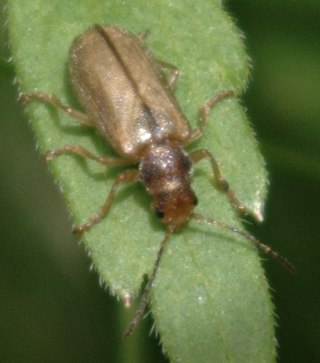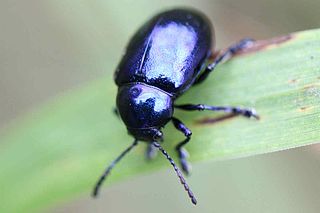
The Synetinae are a small subfamily within the leaf beetle family (Chrysomelidae). They are found entirely within the Holarctic, mainly in North America but also appearing in parts of Europe and Asia. The subfamily contains only two genera, Syneta and Thricolema, with a total of 12 described species. The group is sometimes treated as a tribe of Eumolpinae, where they are known as Synetini.
Pseudocolaspis chrysites is a species of leaf beetle from East Africa and the Arabian Peninsula. It was first described by the German entomologist Carl Eduard Adolph Gerstaecker in 1871. The species is sometimes included within the genus Macrocoma, for example in the Catalogue of Palaearctic Coleoptera.
Macrocoma lefevrei is a species of leaf beetle of Saudi Arabia, Oman, Yemen, Iran and Egypt. It was first described by Joseph Sugar Baly in 1878.
Macrocoma millingeni is a species of leaf beetle of the Arabian Peninsula and Mesopotamia, described by Maurice Pic in 1898.
Macrocoma zarudnii is a species of leaf beetle found in Iran and the United Arab Emirates, described by Igor Lopatin in 1985.
Macrocoma djurdjurensis is a species of leaf beetle of Algeria, described by Andrzej Warchałowski in 2001.
Macrocoma seriesericans is a species of leaf beetle of Algeria, described by Léon Fairmaire in 1876.
Macrocoma haiensis is a species of leaf beetle of Morocco, described by Louis Kocher in 1967.

Eumolpini is a tribe of leaf beetles in the subfamily Eumolpinae. It is the largest tribe in the subfamily, with approximately 170 genera found worldwide. Members of the tribe almost always have a longitudinal median groove on the pygidium, which possibly helps to keep the elytra locked at rest. They also generally have a subglabrous body, as well as appendiculate pretarsal claws.
Macrocoma leprieuri is a species of leaf beetle from North Africa and the Arabian Peninsula to the Horn of Africa. It was first described by Édouard Lefèvre in 1876, as a species of Pachnephorus.
Aoria is a genus of leaf beetles in the subfamily Eumolpinae. Members of the genus are distributed in East and Southeast Asia. Food plants are known for only a few species, all of which were recorded from Vitaceae.
Pseudaoria is a genus of leaf beetles in the subfamily Eumolpinae. It is distributed in East and Southeast Asia. The genus was first established by Martin Jacoby, in a volume of The Fauna of British India posthumously published in 1908, for two newly described species from Manipur and Burma. Pseudaoria is similar to the genus Aoria. In a review of the latter genus in 2012, L.N. Medvedev included Pseudaoria as a subgenus of it.

Chrysochus asclepiadeus is a member of the leaf beetle subfamily Eumolpinae. It is considered the type species of the genus Chrysochus, though it has sometimes been placed within the genus Eumolpus. It is the only species of Chrysochus distributed in the western Palaearctic. It is mainly found in Europe, though it is also known from Kazakhstan and Turkey in Asia.

Bromiini is a tribe of leaf beetles in the subfamily Eumolpinae. The tribe contains approximately 120 genera, which are found worldwide. They are generally thought to be an artificial group, often with a subcylindrical prothorax without lateral ridges and covered with setae or scales.
Macrocoma bolivari is a species of leaf beetle from Morocco. It was first described by Spanish entomologist Manuel Martínez de la Escalera in 1914, as a species of Pseudocolaspis.

Macrocoma setosa is a species of leaf beetle found in Algeria and Morocco It was first described by Hippolyte Lucas in 1846, as a species of Pseudocolaspis.
Macrocoma cylindrica is a species of leaf beetle found in southern Spain. It was first described by Heinrich Carl Küster in 1846, as a species of Pachnephorus. A subspecies or variety of the species later described from Morocco, M. c. vaucheri, is now considered a synonym of Macrocoma setosa.
Macrocoma henoni is a species of leaf beetle from North Africa and Iraq. It was first described by Maurice Pic in 1894, as a species of Pseudocolaspis.

Macrocoma rubripes is a species of leaf beetle from Europe, Asia and possibly North Africa. It was first described by Ludwig Wilhelm Schaufuss in 1862, as a species of Pseudocolaspis.

Phratora tibialis is a species of leaf beetle found in Europe and parts of Asia. This beetle is found on willows and the chemistry and production of its larval defensive secretions and host plant relationships have been studied extensively.





